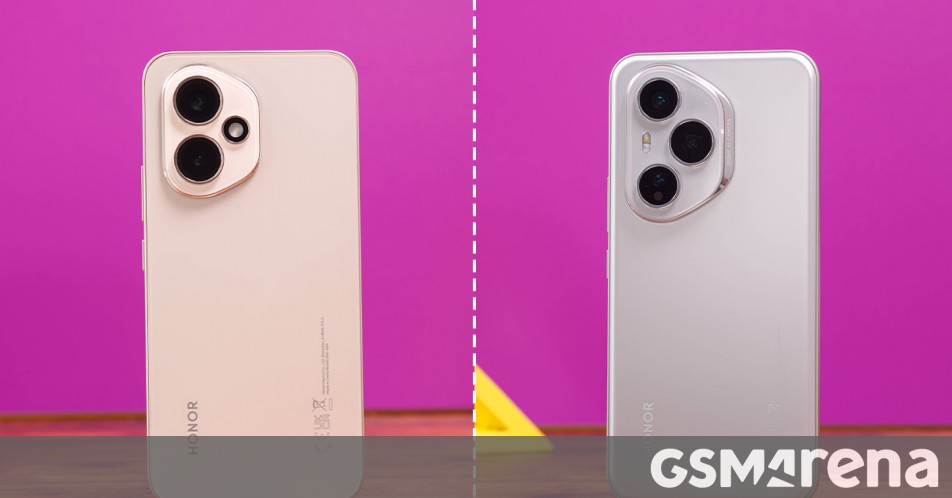Honor 400 vs Honor 400 Pro
If you are eyeing Honor’s latest upper midrangers, the official Honor online store will be happy to offer you the 512GB Honor 400 for around €500 and the 512GB Honor 400 Pro for around €650. So how much better is the Honor 400 Pro to deserve its price premium? Let’s take a closer look.
Table of Contents:
For starters, you can compare the complete specs sheets or directly continue with our editor’s assessment in the following text.
Size comparison
At first glance, the Honor 400 and 400 Pro share a similar design DNA, but there are key differences in execution and ergonomics. The vanilla model is noticeably more compact and lighter at 184g versus the 205g of the Pro. The Honor 400 also has flatter sides and a slimmer profile, making it a bit easier to handle, especially with one hand. The Pro, in contrast, features slightly curved glass on both the front and back, lending it a more premium feel in hand but also making it a bit more slippery.
While both phones offer a glass back, the Pro steps up to an arguably more refined finish. The Pro’s overall design is more reminiscent of a flagship, while the vanilla model feels more utilitarian—though still modern and attractive in its own right.
When it comes to buttons and controls, both devices feature the standard volume rocker and power button arrangement on the right-hand side. Both phones lack a 3.5mm headphone jack, and neither includes a microSD card slot, though you do get dual SIM support. There’s official ingress protection rating on both phones but the vanilla Honor 400 has to settle for market-dependent IP65/IP66 protection, while the Pro has IP68/IP69 certification.
Connectivity is mostly equal between the two, with both phones offering 5G, dual-band Wi-Fi (though the Pro does come with tri-band Wi-Fi in some markets), Bluetooth 5.4, NFC, and USB-C 2.0.
Visually, both phones feature large camera islands on the back, but the Pro’s is a bit more stylized, with more emphasis on lens detailing. Despite the similarities in branding, the Honor 400 Pro clearly positions itself as the more luxurious and refined device in both appearance and feel.
Display comparison
Both phones feature AMOLED displays with a 120Hz refresh rate and support for 10-bit color, offering vibrant visuals and smooth animations. The Honor 400 Pro has a slightly larger 6.7-inch screen compared to the 6.55-inch panel on the regular Honor 400. Despite the difference in size, both panels deliver similar sharpness, with a matching pixel density of around 460ppi.
The regular Honor 400 actually achieves a slightly higher max brightness of 1,550 nits, compared to 1,481 nits on the Pro model, but the difference is really small. Both displays perform well outdoors. Both are well-calibrated and support HDR10+, making them equally capable for multimedia consumption.
Battery life
Both phones come with identical 5,300mAh battery capacities in Europe, but their real-world endurance differs significantly. The Honor 400 Pro outlasts its sibling with an impressive Active Use Score of 13:54h, while the regular Honor 400 manages a still respectable but shorter 12:29h. This advantage is particularly notable given the more powerful chipset in the Pro, which appears to be well-optimized for power efficiency.
In day-to-day use, both phones deliver solid longevity and can easily get you through a full day of mixed usage. However, the Pro model holds a slight upper hand when it comes to screen-on time. If battery life is a priority, the Honor 400 Pro offers a bit more peace of mind.
Charging speed
Charging is quick on both devices, but the Honor 400 Pro edges out with its 100W charging support, reaching a full charge in just 38 minutes. The standard Honor 400 isn’t far behind with its 80W charging, taking 41 minutes for a full top-up. Neither phone comes with a charger in the box, at least not in Europe.
Speaker test
Both the Honor 400 and 400 Pro come with stereo speakers, but the 400 Pro is louder and delivers slightly more bass and fullness. The regular Honor 400 performs reasonably well but it falls behind in sound quality. Neither phone includes a headphone jack, though, so it’s wireless or USB-C audio all the way.
Performance
The performance gap between the Honor 400 and Honor 400 Pro is significant and immediately noticeable. The vanilla model is powered by the Snapdragon 7 Gen 3 chipset – a competent mid-range platform built on a 4nm process. It delivers smooth day-to-day performance and handles multitasking and moderate gaming well, but it’s clearly not aimed at power users.
The Honor 400 Pro, on the other hand, steps into flagship territory with the Snapdragon 8 Gen 3. This is one of the fastest mobile chipsets currently available, also built on a 4nm process, but with vastly superior CPU and GPU performance. It handles demanding 3D games, intensive workloads, and high frame rate usage with ease. In synthetic benchmarks, the Pro achieves roughly double the scores of its vanilla sibling, especially in GPU-heavy tasks like 3DMark Wild Life.
As for memory configurations, the base Honor 400 ships with 8GB of RAM and 256GB of storage, while the Honor 400 Pro ups the ante with 12GB of RAM in its base variant, also paired with 256GB of storage. Neither phone includes a microSD slot, so internal storage is all you get.
Both phones ship with nearly identical Android 15 builds with MagicOS 9 on top and promise up to six major OS updates.
If raw performance and long-term fluidity are important to you, the Honor 400 Pro easily justifies its premium with cutting-edge hardware. The Honor 400, while perfectly adequate for casual users, simply can’t compete in this department.
Benchmark performance
The numbers speak for themselves. The Honor 400 Pro posts nearly double the benchmark scores of the regular Honor 400 across the board. In AnTuTu 10, the Pro reaches an impressive 1.9 million points compared to the 864K of the vanilla model. Geekbench 6 further highlights the gap with single-core and multi-core scores practically doubling on the Pro, and 3DMark Wild Life showcases the raw GPU muscle of the Snapdragon 8 Gen 3, scoring over three times higher than the Snapdragon 7 Gen 3 in the Honor 400.
These synthetic benchmarks translate into real-world differences in speed, responsiveness, and sustained performance. The Pro feels snappier in general navigation and loads games more quickly. It also handles multitasking more gracefully thanks to its larger RAM. The regular Honor 400 performs fine for casual use and light gaming, but it begins to show its limitations when pushed. If you’re looking for a phone that will stay fast and smooth for years, the 400 Pro is the obvious winner.
Camera comparison
Both the Honor 400 and Honor 400 Pro capitalize on a flagship-grade Samsung ISOCELL HP3 sensor for their 200 MP main camera.
However, their secondary sensors differ significantly. The Honor 400 just has a 12 MP ultra-wide camera (112° FOV, f/2.2), relying on cropping from the main sensor for any zooming. The Honor 400 Pro is much more well-rounded: it adds a Sony IMX856 50 MP telephoto camera (3x optical zoom, OIS) alongside the same 12 MP ultra-wide. That telephoto lens allows the Pro to produce true optical zoom shots and extends clarity up to 6x hybrid and even 10x with AI upscaling.
Selfie-wise, both models sport the same 50 MP front camera with 4K video recording, but with fixed focus. The results here are essentially identical—sharp and well-exposed, though the Pro’s extra depth sensor on the front offers marginally better portrait separation.
Image quality
Both the Honor 400 and 400 Pro leverage the same Samsung ISOCELL HP3 200 MP main sensor (1/1.4″ with OIS+EIS), and in daylight, they deliver crisp, high-detail shots with pleasing dynamic range and vivid yet natural colors. The large sensor consistently produces rich textures and accurate exposure in well-lit environments.
The ultrawide on both devices, a 12MP shooter with a 112° field-of-view, handles wide shots reasonably well but shows a notable drop in detail and contrast when compared to the main cam. That said, it remains serviceable for landscapes and group shots.
The Honor 400 Pro adds a real differentiator: its 50 MP Sony IMX856 telephoto with 3x optical zoom and OIS. This unit succeeds in delivering sharp, clear zoomed-in images up to 3x, maintains usable quality up to 6x with hybrid zoom and AI assist. The vanilla Honor 400 lacks this capability and relies on digital crops, which, while surprisingly decent thanks to the high-res main sensor, don’t match the Pro’s optical clarity.
















Honor 400: 0.6x • 1x • 2x • 3x
















Honor 400 Pro: 0.6x • 1x • 2x • 3x
In low light, the Pro takes a small lead. Its main camera produces sharper shots with more preserved texture and less aggressive noise reduction. Night Mode kicks in automatically on both phones and does a good job of balancing highlights and shadows. The vanilla Honor 400 holds its own with good exposure and respectable detail, but darker areas can become mushy, and fine textures are often lost.












Honor 400: 0.6x • 1x • 2x • 3x












Honor 400 Pro: 0.6x • 1x • 2x • 3x
Video quality
Video capture from the main cameras on both the Honor 400 and Honor 400 Pro is generally quite good, thanks to the shared Samsung ISOCELL HP3 200MP sensor. Daylight footage from either phone is sharp, detailed, and features balanced colors with a slightly saturated but pleasing tone. Dynamic range is respectable.
Stabilization is available on both models and works well, but footage from the Pro appears a bit steadier during panning and walking shots.
Low-light video is pretty comparable across both phones. You can count on solid clips from the main cameras and probably want to avoid the ultrawide after dark altogether.




Honor 400: 0.6x • 1x • 2x • low-light




Honor 400 Pro: 0.6x • 1x • 3x • low-light
The presence of a dedicated 50MP telephoto camera on the Honor 400 Pro gives it a clear advantage when it comes to zoomed videos. The optical zoom delivers noticeably sharper and more stable results than the digitally cropped zoom from the main sensor on the vanilla model. The Honor 400 lacks this versatility and quickly loses detail once you move beyond a basic crop.
Verdict
While the Honor 400 and Honor 400 Pro share a name and several core components—including their main, ultrawide, and selfie cameras—they are ultimately targeting very different users.
The regular Honor 400 offers great value for its price. It’s compact, lightweight, and its display is as bright as the Pro’s plus some. With the same high-resolution main camera and solid overall performance for day-to-day tasks, it covers the needs of most casual users without overspending. If you’re after the core Honor experience at a more accessible price point, the vanilla 400 is easy to recommend.
The Honor 400 Pro, on the other hand, makes a compelling case for those willing to spend more for a true flagship experience. You get top-tier performance thanks to the Snapdragon 8 Gen 3, longer battery life, faster charging, and a far more versatile camera system that includes a dedicated telephoto lens. It’s the better phone overall, and the premium feel, higher ingress protection, and superior zoom and video quality justify its cost – assuming your budget can stretch that far.
In the end, the Honor 400 Pro wins on features and performance, but the Honor 400 remains a strong contender for users seeking value without sacrificing core quality. The decision comes down to what you’re willing to pay for – and whether you’ll really take advantage of the Pro’s extra horsepower and optics.
- The more compact and lighter design.
- The identical user experience.
- The same display, as well as main, ultrawide, and selfie cameras.
- The lower price.
Get the Honor 400 5G for:









